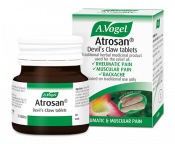How do you keep your joints healthy?
If you experience a joint-related issue, here are a few tips you can implement to help keep the joints healthy:
- Address your diet
- Try a herbal remedy like Devil's Claw
- Drink more water and nettle tea
- Exercise more
- Apply heat
Read on to find out a bit more about why these things can help your joints.
1. Dietary do’s
Inflammation is the main thing to consider when it comes to diet and joint health. Fresh, unprocessed foods that aren't likely to trigger inflammation should be the priority.
Meanwhile, white flour, white pasta, white sugar and caffeine have a tendency to cause inflammation so try to avoid these in favour of brown varieties of pasta and rice. Limit refined sugar intake and experiment with alternatives such as Sweet Freedom or coconut blossom sugar. You could also opt for a caffeine-free drink like Bambu or a herbal tea.
Meat can also be inflammatory, whereas fish and vegan forms of protein are not as irritating. You could aim to go 'veggie' for at least one day a week to help get more of these ingredients in your diet.
2. Dietary don’ts
Don't rely heavily on dairy products if you're prone to joint problems like arthritis. When there is an overload of calcium in the diet, the body can struggle to absorb it correctly, especially in the absence of sufficient vitamin D. Calcium absorption can also be hindered by lack of magnesium so a focus on this nutrient is helpful.
Magnesium-rich foods:
|
A common issue to affect the joints is gout. This is caused by a build up of uric acid which settles in the small joints of the hands and feet instead of being flushed out by the kidneys. It causes pain and swelling in the joints, as well as reduced mobility.
Dietary factors can play a big part in the development of gout. Over-processed diets full of meat, dairy, alcohol, salt, sugar and caffeine can all lead to problems. At the same time, including too few alkalizing foods (tofu, fruit, vegetables, legumes, nuts, seeds) and drinking too little water will cause issues with gout.
3. Call for herbal help
A little niggle in the joints here or there may benefit from topical application of Arnica, to help calm the discomfort. This is also a very good option if you've had a bump or a minor injury to the joint (as long as the skin is not broken!).
However, for longer term issues you may want to think about using Devil's Claw. This is a herbal remedy that reduces inflammation without any of the problems associated with either steroid or non-steroidal anti-inflammatory medications. It can be used long or short-term and is not commonly associated with any side effects. It is not contraindicated with other medication and is available as a tincture or tablets.
A.Vogel Atrosan Devil’s Claw tablets for aches and pains - 60 tablets

- Relieves muscle and joint pain
- For rheumatic pain, backache or lumbago
- Made from extracts of cultivated Devil's Claw rather than endangered wild harvested herb
- Can be used with other medicines
"Easy to take and have noticed some relief after a few weeks of taking"
4. Drink up!
Water is really the best drink for joint issues. With gout, in particular, upping your water intake, alongside drinking some nettle tea, can help to get rid of uric acid.
To make your own nettle tea, snip the top off young nettle plants and steep in boiling water for 5 minutes before removing the nettles. Failing that, nettle tea is widely available in health stores and supermarkets.
For those in need of a stronger effect, nettle tincture is also available.
5. Make your body move
Improve mobility and flexibility by making your body move on a regular basis. Movement is also very good for issues like stiffness and pain, plus it can reduce the likelihood of weight gain – a key contributing factor in knee problems, in particular.1
My Self-Care Tip: Low impact exercises for the joints
Check out the kinds of activities that are a little bit friendlier on the joints.
6. Warmth
If you already experience joint pain, heat can be really beneficial. It relaxes much tension and can help considerably with different types of pain. A warm bath or heat pack are good options but also remember to keep wrapped up warm when you head outside and ensure your home is toasty too!








